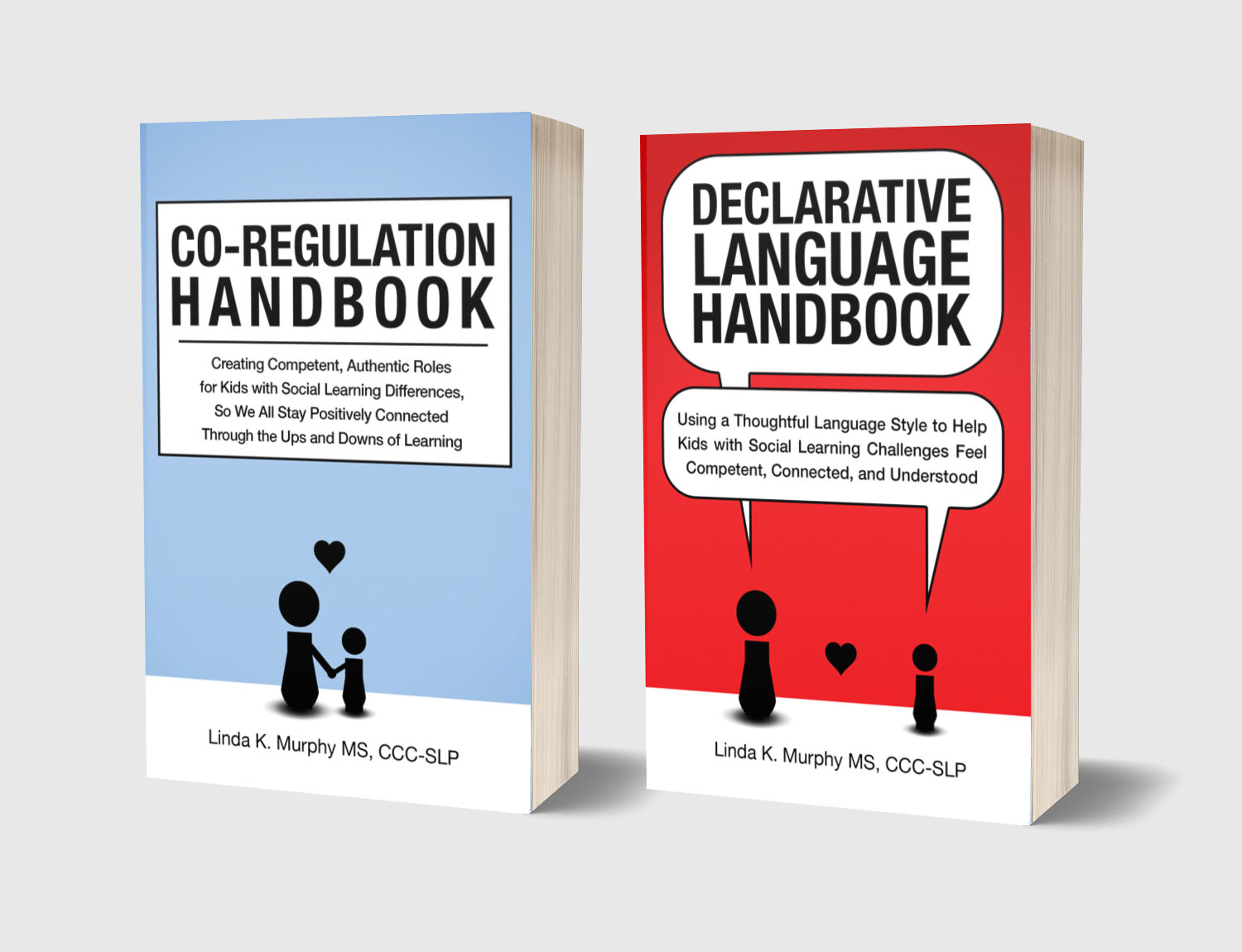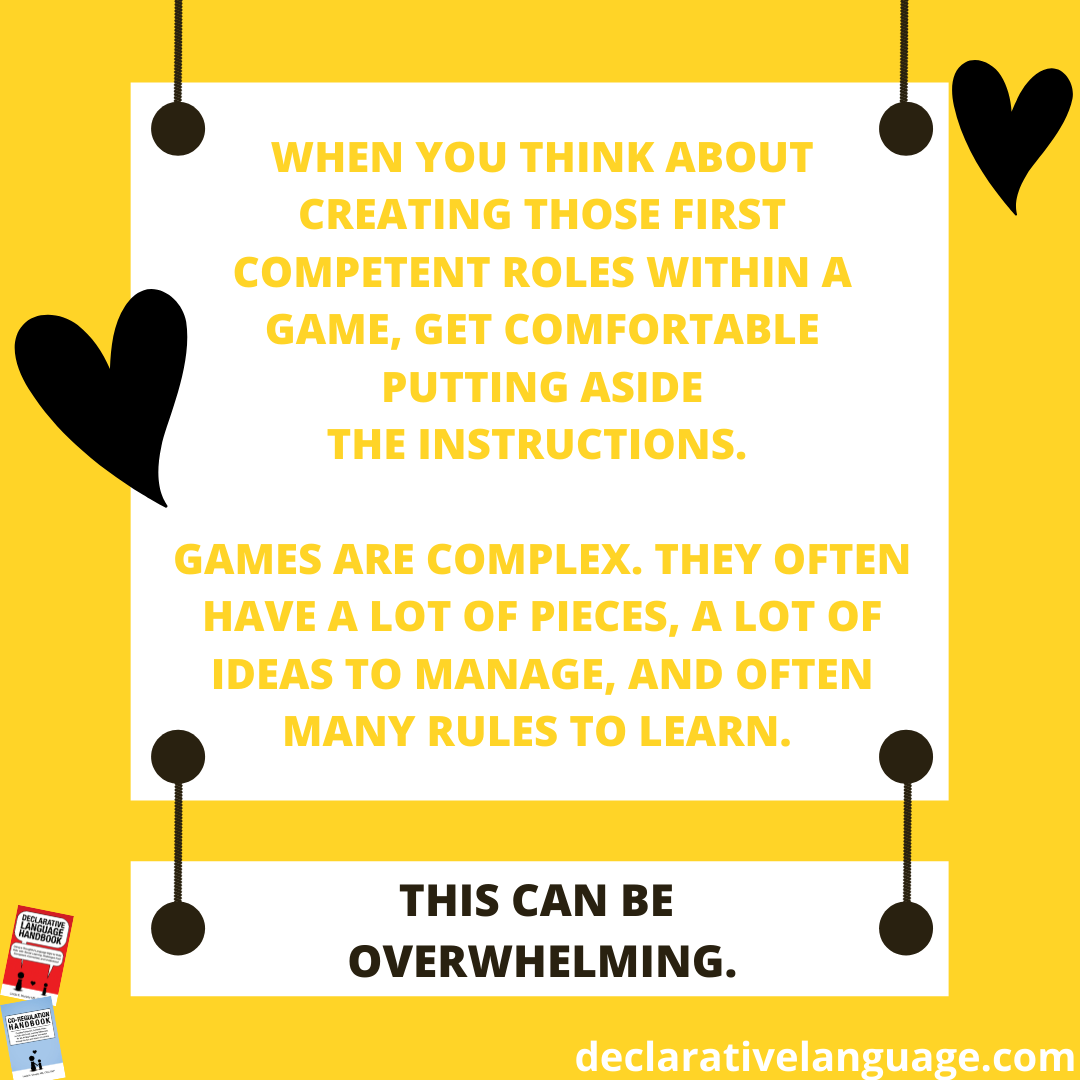Building on Competence…
Last week, I shared information about one of my favorite games – Mastermind! This week, I want to talk about how to scaffold this game, while introducing you to a general framework of how to scaffold any game, really. In short, you start by creating competent roles for your child, and expand as your child is ready.
I talk about this process a lot in Co-Regulation Handbook.
To back up for a minute… creating a competent role for your child means: Finding that opportunity or role within what you are doing, that your child can do on their own, with just a little bit of time and/or just a little bit of help. That’s it.
This lens can change everything you do.
Importantly, if you find yourself prompting a lot and/or asking a lot of questions, then chances are, it is not a competent role for the child. This is okay. Just take a moment, step back, and try again.
Now, back to games.
When you think about creating those first competent roles within a game, such as Mastermind, get comfortable putting aside the instructions. (I talk about this in Part 5 of CR Handbook: Peer Interactions & Friendships).
Games are complex, they often have a lot of pieces, a lot of ideas to manage, and often many rules to learn. This can be overwhelming.
Instead, we want to scale back and just recognize the basic pattern of the game. All games have them. And then, give kids a chance to master the pattern in its simplest form, before adding any more complexity (pieces, turns, players, rules, etc.).
Also, never start with a competitive focus. That’s a whole other set of demands that I can get to in another post!
Your first goal is to simply get the child comfortable with the gameboard, some of the pieces, and the general ideas (or pattern) of the game. You are building competence from the ground up.
For Mastermind, the pattern in its simplest form is: “I hide ONE peg and you figure out which ONE I hid.”
As you guide and teach at this first level, get your declarative language hat on! You will be guiding these new ideas through commenting, or thoughtful DL statements. It can be easy to fall back into asking questions as you teach a new game to your child (What color should you guess? What does this mean? Where should you move next?). But please don’t do that. It just adds more demands to a novel context, where the child is working to learn. Questions may also trigger feelings of incompetence (fight/flight/freeze) and decrease enjoyment of the game. We want to build positive memories around your time together, so the child wants to come back for more another day. So, no quizzing, okay?
Here is how this all comes together for Mastermind.
Last week I mentioned the roles of the game: “code-maker” and “code-breaker”. When I first introduce the game, I usually let the child be the “code-maker” and I am the “code-breaker.” I do this because I know the code-maker is the simpler role starting out, and I want to ensure the child will be successful.
Then, I start with only one peg so that they learn the pattern in its simplest form. Once they know the pattern, adding complexity will be easier to do.
Using DL, I guide the child towards their competent role: “I’m going to close my eyes, and you can pick ONE color and then put it in this hole right here. When you are done, you can cover it up like this (modeling for them how the cover works). Once you are ready, I will open my eyes.”
Then…once they are ready:
“Okay… so right now, you know your color, but I don’t because I didn’t see it (perspective taking) … I am going to try and guess your color, by placing a peg here” (modeling how I am trying something, even though I don’t yet know the right answer).
I place one peg, let’s say it’s red.
Me: “Now, you get to tell me if my guess is right. Is it red?”
I wait quietly for the child to head nod, head shake or say yes or no in any form. Let’s imagine I was wrong.
Me: “Hmmm… okay, so since your color is NOT red, I am going to guess again on this next row. I will pick a color that is NOT red….” (modeling how I am using what I have learned)
I place blue this time.
Me: “I’m wondering if your color is blue…”
They respond… Let’s say I am still wrong.
I narrate my thought process with DL again: “Okay, so that means I need to guess again, on the next row. I know your color is NOT red, and NOT blue so hmmm… I think I will guess green this time” (again, I am modeling how I am using my recently gained knowledge to solve the problem at hand).
I place green.
This time I’ve got it, the child communicates yes! I then show them how to reveal their peg: “Great! I figured it out! Now, you can show me by lifting the cover off.”
Together we see the match up. Success! They are starting to learn the game.
At this point, I may invite them to swap roles using DL:
“I’m wondering if you would like to be the “code-breaker now…”
I’ve modeled how it works, so kids are often ready at this point to swap roles, and keeping the game at this level (one peg only) ensures it is a safe learning opportunity.
But if they are not yet ready, that is okay too. We repeat that pattern, in our existing roles.
When they do become the code-breaker, I use similar DL in reverse. For example:
“Okay, so you just guessed red, but that is NOT my color…… That means, you want to pick a color that is NOT red on your next guess.”
Or…
“You’ve learned that my color is NOT red, and NOT yellow…. Let’s think about what color it might be. I will help you if you need it…”
Remember. No questions, just guide with DL statements to help the child notice, remember and discover. Also, be sure to wait quietly in between statements so the child can think.
Adding complexity…
Only AFTER I see that they have mastered this initial pattern, do I introduce the idea of adding another peg. This is really important. If we go too fast, and add complexity before the child is ready – they won’t feel competent, they may not be competent, and it may impact their willingness to stay in the game or try again on a different day.
It is crucial to build on competence in this way, so that when we increase the challenge to two pegs, we are doing it BECAUSE we know the child is ready.
When we get to that point, my DL might sound like this: “I think you have a good handle on this now, and are probably ready for a little more! I’d love to hide two pegs instead of one, if you feel ready too!”
If they are ready, we go there. But if they are not, that is okay too. We keep as is until they feel comfortable with the introduction of a small challenge. I know we will get there as long as I am patient.
As I introduce this next challenge (two pegs instead of one), I go back to the role set-up that I know will be more competent: I am the code-breaker, and they are the code-maker. And, I then guide their next steps in the learning process using DL again (i.e., how we use the tiny red and white pegs, how to interpret and build upon more complex information, etc.).
Again, I don’t need to get there quickly, I just need to get there at a pace that keeps the child competent, successful, and in the game. I continue in this way, slow and steady, over the course of time, adding more colors, as they are ready. We may get to all four colors within that play opportunity, or it may be on a different day, a different week, or a different month! It is all good.
The important piece is that I’m building on their competence, a little at a time, so they feel it too. When we do this, we allow kids to also feel and experience mastery! And, when kids feel mastery, they often seek out the next challenge on their own.
In other words, they become an active, authentic partner in their own growth and learning journey. And that, is everything!
Have a great week!
If you like my Sunday Snippets of Support, you can receive them directly to your inbox here.






